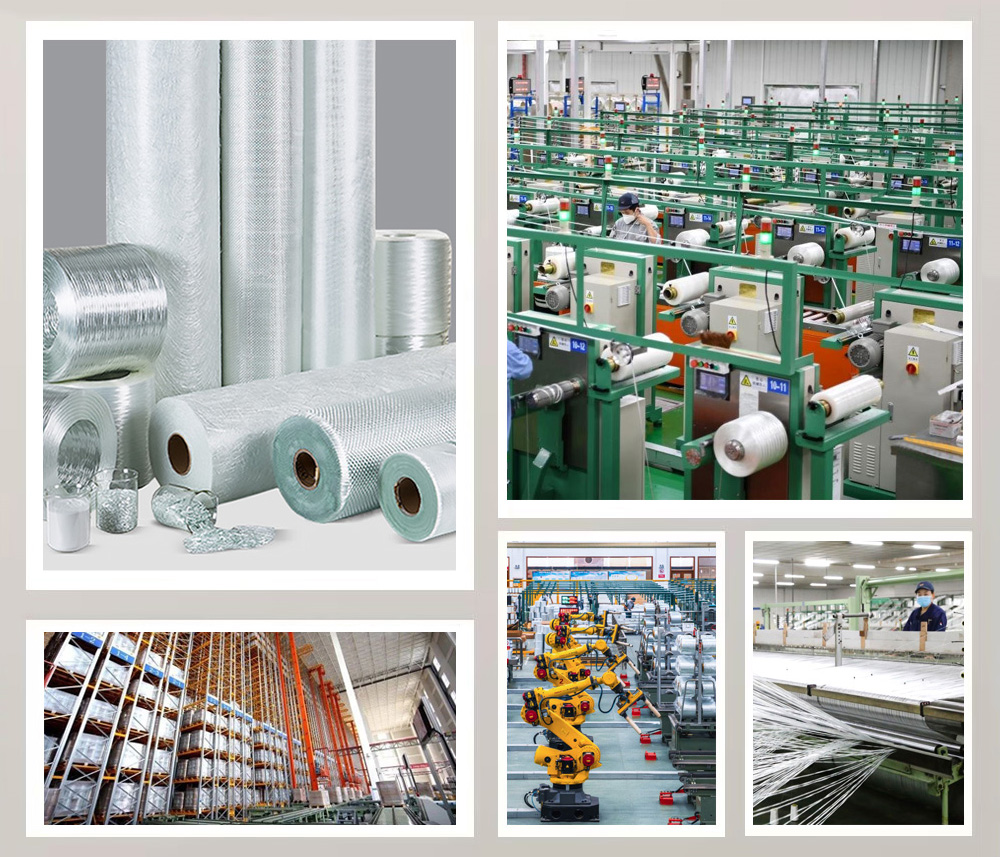To fiberglass roving woven with a variety of fiberglass fabrics.
(1)Fiberglass fabric
Fiberglass fabric is divided into two categories non-alkali and medium alkali, glass cloth is mainly used in the production of a variety of electrical insulation laminates, printed circuit boards, a variety of vehicle hulls, storage tanks, boats, molds, and so on. The medium alkali glass cloth is mainly used in the production of plastic-coated packaging cloth, as well as for corrosion-resistant occasions. The characteristics of the fabric are determined by fiber properties, warp and weft density, yarn structure, and weave pattern. The warp and weft density is in turn determined by the yarn structure and weave pattern. The warp and weft density, together with the yarn structure, determines the physical properties of the fabric, such as weight, thickness, and breaking strength. There are five basic weave patterns: plain, twill, satin, rib, and mat.
(2) Fiberglass tape
Fiberglass tape is divided into woven edges with and without woven edges (burlap tape) is the main weave plain. Glass tape is commonly used in the manufacture of high-strength, good dielectric properties of electrical equipment parts.
(3) unidirectional fabrics
Unidirectional fabric is a thick warp and weft yarn woven into a four-warp broken satin or long-axis satin fabric. It is characterized by high strength in the main warp yarn upwards.
(4) 3D Fiberglass Woven Fabric
3D Fiberglass Woven Fabric is relative to the plane fabric, its structural features from one-dimensional two-dimensional development to three-dimensional, so that the composite material as a reinforcing body has good integrity and profiling, greatly improving the composite material interlayer shear strength and damage tolerance. It was developed with the special needs of aerospace, aviation, weapons, ships, and other sectors, and today its application has been expanded to automotive, sports equipment, medical equipment, and other sectors. There are five main categories: woven three-dimensional fabrics, knitted three-dimensional fabrics, orthogonal and non-orthogonal non-woven three-dimensional fabrics, three-dimensional woven fabrics, and other forms of three-dimensional fabrics. Three-dimensional fabrics in the shape of blocks, columns, tubes, hollow truncated cones, and variable thickness-shaped cross-sections.
(5) Shaped fabrics
The shape of the fabric and it is to enhance the shape of the product is very similar, and must be woven on a special loom. Symmetrical shaped shaped fabrics are: round covers, cones, caps, dumbbell-shaped fabrics, etc., and can also be made into boxes, hulls, and other asymmetric shapes.
(6) groove core fabrics
Groove core fabric is made of two parallel layers of fabric, with longitudinal vertical strips connected by the fabric, its cross-section shape can be triangular or rectangular.
(7) Fiberglass Stitched Mat
Known as knitted or woven felt, it differs from ordinary fabrics and felt in the usual sense. The most typical sewn fabric is a layer of warp yarns overlapped with a layer of weft yarns, and the warp and weft yarns are woven together into a fabric by sewing.
The advantages of fiberglass stitched mat are as follows.
① It can increase the ultimate tensile strength of FRP laminated products, delamination resistance under tension, and flexural strength;
② Reduce the weight of FRP products.
③ Surface leveling makes the surface of FRP smooth;
④ Simplify the hand lay-up operation and improve the quality of FRP products.
Simplify the hand-laying operation and improve the labor productivity. This reinforcing material can be pultruded fiberglass and RTM instead of continuous filament mat, but also in the centrifugal fiberglass pipe production to replace the chevron cloth.
(8) Fiberglass Insulation Sleeving
Braided into tubes with fiberglass roving. And coated with resin material made of various insulation-grade casings. There are PVC resin glass fiber paint tubes. Acrylic glass fiber paint tube, silicone resin glass fiber paint tube.
Post time: Jan-16-2025






